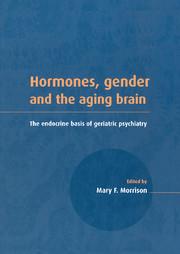Book contents
- Frontmatter
- Contents
- List of contributors
- Preface
- Acknowledgments
- Part I Overview
- Part II Hormones and mental health in the elderly
- Part III Effects of hormones and behavior on immune function
- Part IV Hormones and gender differences in psychotropic drug metabolism
- 15 Gender differences in psychotropic drug metabolism
- 16 The influence of progesterone on the pharmacokinetics and pharmacodynamics of gamma–aminobutyric acid–active drugs
- Index
15 - Gender differences in psychotropic drug metabolism
from Part IV - Hormones and gender differences in psychotropic drug metabolism
Published online by Cambridge University Press: 18 September 2009
- Frontmatter
- Contents
- List of contributors
- Preface
- Acknowledgments
- Part I Overview
- Part II Hormones and mental health in the elderly
- Part III Effects of hormones and behavior on immune function
- Part IV Hormones and gender differences in psychotropic drug metabolism
- 15 Gender differences in psychotropic drug metabolism
- 16 The influence of progesterone on the pharmacokinetics and pharmacodynamics of gamma–aminobutyric acid–active drugs
- Index
Summary
Introduction
A consideration of the problem of gender differences in psychotropic drug metabolism recapitulates many of the same concerns of geriatric clinical psychopharmacology. Older women are the greatest consumers of all classes of psychotropics, and there is evidence that the elderly in general, and women in particular, experience a higher frequency of adverse drug reactions (Hurwitz, 1969; Domecq et al., 1980; Makkar et al., 1993; Warren et al., 1994). Yet drugs undergo phase one and early phase two testing predominantly in young male volunteers, a trend that has strongly increased over the past two decades (Schmucker & Vesell, 1993). This was to some extent mandated in 1977 by prior Food and Drug Administration guidelines which restricted enrollment of ‘women of childbearing potential,’ and reinforced, by the rather circular logic, that ‘gender differences in pharmacokinetics are not worth studying systematically, yet just in case there is a variance due to gender, it should be excluded as a variable.’ This of course prevented the accumulation of the necessary data to actually determine whether gender is indeed an issue in drug metabolism and response. Moreover, when women were included in early drug studies, they were usually young and there was seldom stratification by sex according to alcohol use, smoking, or use of oral contraceptives. Only three or four published studies in the area have controlled for menstrual phases. In addition, it is now recognized that single dose pharmacokinetic studies are not sufficient to examine nonlinear clearance phenomena.
- Type
- Chapter
- Information
- Hormones, Gender and the Aging BrainThe Endocrine Basis of Geriatric Psychiatry, pp. 321 - 333Publisher: Cambridge University PressPrint publication year: 2000



